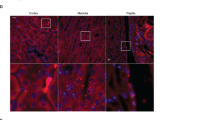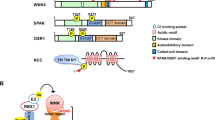Abstract
Thiazolidinediones (TZDs) are widely used to treat type 2 diabetes mellitus; however, their use is complicated by systemic fluid retention. Along the nephron, the pharmacological target of TZDs, peroxisome proliferator-activated receptor-γ (PPARγ, encoded by Pparg), is most abundant in the collecting duct. Here we show that mice treated with TZDs experience early weight gain from increased total body water. Weight gain was blocked by the collecting duct–specific diuretic amiloride and was also prevented by deletion of Pparg from the collecting duct, using Ppargflox/flox mice. Deletion of collecting duct Pparg decreased renal Na+ avidity and increased plasma aldosterone. Treating cultured collecting ducts with TZDs increased amiloride-sensitive Na+ absorption and Scnn1g mRNA (encoding the epithelial Na+ channel ENaCγ) expression through a PPARγ-dependent pathway. These studies identify Scnn1g as a PPARγ target gene in the collecting duct. Activation of this pathway mediates fluid retention associated with TZDs, and suggests amiloride might provide a specific therapy.
This is a preview of subscription content, access via your institution
Access options
Subscribe to this journal
Receive 12 print issues and online access
$209.00 per year
only $17.42 per issue
Buy this article
- Purchase on Springer Link
- Instant access to full article PDF
Prices may be subject to local taxes which are calculated during checkout




Similar content being viewed by others
References
Yki-Jarvinen, H. Thiazolidinediones. N. Engl. J. Med. 351, 1106–1118 (2004).
Mudaliar, S., Chang, A.R. & Henry, R.R. Thiazolidinediones, peripheral edema, and type 2 diabetes: incidence, pathophysiology, and clinical implications. Endocr. Pract. 9, 406–416 (2003).
Page, R.L. II, Gozansky, W.S. & Ruscin, J.M. Possible heart failure exacerbation associated with rosiglitazone: case report and literature review. Pharmacotherapy 23, 945–954 (2003).
King, K.A. & Levi, V.E. Prevalence of edema in patients receiving combination therapy with insulin and thiazolidinedione. Am. J. Health Syst. Pharm. 61, 390–393 (2004).
Nesto, R. C-reactive protein, its role in inflammation, Type 2 diabetes and cardiovascular disease, and the effects of insulin-sensitizing treatment with thiazolidinediones. Diabet. Med. 21, 810–817 (2004).
Nesto, R.W. et al. Thiazolidinedione use, fluid retention, and congestive heart failure: a consensus statement from the American Heart Association and American Diabetes Association. October 7, 2003. Circulation 108, 2941–2948 (2003).
Guan, Y., Zhang, Y., Davis, L. & Breyer, M.D. Expression of peroxisome proliferator-activated receptors in urinary tract of rabbits and humans. Am. J. Physiol. 273, F1013–F1022 (1997).
Yang, T. et al. Expression of peroxisomal proliferator-activated receptors and retinoid X receptors in the kidney. Am. J. Physiol. 277, F966–F973 (1999).
Kleyman, T.R., Sheng, S., Kosari, F. & Kieber-Emmons, T. Mechanism of action of amiloride: a molecular prospective. Semin. Nephrol. 19, 524–532 (1999).
Velazquez, H. & Wright, F.S. Effects of diuretic drugs on Na, Cl, and K transport by rat renal distal tubule. Am. J. Physiol. 250, F1013–F1023 (1986).
Stricklett, P.K., Nelson, R.D. & Kohan, D.E. Targeting collecting tubules using the aquaporin-2 promoter. Exp. Nephrol. 7, 67–74 (1999).
Nelson, R.D. et al. Expression of an AQP2 Cre recombinase transgene in kidney and male reproductive system of transgenic mice. Am. J. Physiol. 275, C216–C226 (1998).
Jones, J.R., Shelton, K.D., Guan, Y., Breyer, M.D. & Magnuson, M.A. Generation and functional confirmation of a conditional null PPARγ allele in mice. Genesis 32, 134–137 (2002).
Soriano, P. Generalized lacZ expression with the ROSA26 Cre reporter strain. Nat. Genet. 21, 70–71 (1999).
Suzuki, J., Furutoh, K. & Nishikibe, M. A new system using NMR technology for measurement of body composition in experimental animals. Nippon Yakurigaku Zasshi 123, 281–287 (2004).
Schreyer, S.A., Lystig, T.C., Vick, C.M. & LeBoeuf, R.C. Mice deficient in apolipoprotein E but not LDL receptors are resistant to accelerated atherosclerosis associated with obesity. Atherosclerosis 171, 49–55 (2003).
Taicher, G.Z., Tinsley, F.C., Reiderman, A. & Heiman, M.L. Quantitative magnetic resonance (QMR) method for bone and whole-body-composition analysis. Anal. Bioanal. Chem. 377, 990–1002 (2003).
Whitehead, R.H., VanEeden, P.E., Noble, M.D., Ataliotis, P. & Jat, P.S. Establishment of conditionally immortalized epithelial cell lines from both colon and small intestine of adult H-2Kb-tsA58 transgenic mice. Proc. Natl. Acad. Sci. USA 90, 587–591 (1993).
Schafer, J.A. Abnormal regulation of ENaC: syndromes of salt retention and salt wasting by the collecting duct. Am. J. Physiol. Renal Physiol. 283, F221–F235 (2002).
Hummler, E. Epithelial sodium channel, salt intake, and hypertension. Curr. Hypertens. Rep. 5, 11–18 (2003).
Garty, H. & Palmer, L.G. Epithelial sodium channels: function, structure, and regulation. Physiol. Rev. 77, 359–396 (1997).
Barbry, P. & Hofman, P. Molecular biology of Na+ absorption. Am. J. Physiol. 273, G571–G585 (1997).
Hummler, E., Merillat, A.M., Rubera, I., Rossier, B.C. & Beermann, F. Conditional gene targeting of the Scnn1a (αENaC) gene locus. Genesis 32, 169–172 (2002).
Herring, S.W., Sadnik, I. & Moldave, K. Studies on the mechanism of action of a eukaryotic codon-dependent factor specific for initiator Met-tRNAf and ribosomal 40 S subunits. J. Biol. Chem. 257, 4882–4887 (1982).
Leesnitzer, L.M. et al. Functional consequences of cysteine modification in the ligand binding sites of peroxisome proliferator activated receptors by GW9662. Biochemistry 41, 6640–6650 (2002).
Stec, D.E., Davisson, R.L., Haskell, R.E., Davidson, B.L. & Sigmund, C.D. Efficient liver-specific deletion of a floxed human angiotensinogen transgene by adenoviral delivery of Cre recombinase in vivo. J. Biol. Chem. 274, 21285–21290 (1999).
Wang, Y., Krushel, L. & Edelman, G. Targeted DNA recombination in vivo using an adenovirus carrying the cre recombinase gene. Proc. Natl. Acad. Sci. USA 93, 3932–3936 (1996).
Lee, C.H. et al. Transcriptional repression of atherogenic inflammation: modulation by PPARδ. Science 302, 453–457 (2003).
Picard, F. et al. Sirt1 promotes fat mobilization in white adipocytes by repressing PPAR-γ. Nature 429, 771–776 (2004).
Helledie, T. et al. The gene encoding the Acyl-CoA-binding protein is activated by peroxisome proliferator-activated receptor γ through an intronic response element functionally conserved between humans and rodents. J. Biol. Chem. 277, 26821–26830 (2002).
Weisz, O.A. & Johnson, J.P. Noncoordinate regulation of ENaC: paradigm lost? Am. J. Physiol. Renal Physiol. 285, F833–F842 (2003).
Konstas, A.A. & Korbmacher, C. The γ-subunit of ENaC is more important for channel surface expression than the β-subunit. Am. J. Physiol. Cell Physiol. 284, C447–C456 (2003).
Volk, K.A., Husted, R.F., Sigmund, R.D. & Stokes, J.B. Overexpression of the epithelial Na+ channel subunit in collecting duct cells: interactions of Liddle's mutations and steroids on expression and function. J. Biol. Chem. 280, 18348–18354 (2005).
Hong, G. et al. PPARγ activation enhances cell surface ENaCα via up-regulation of SGK1 in human collecting duct cells. FASEB J. 17, 1966–1968 (2003).
Friedrich, B. et al. The serine/threonine kinases SGK2 and SGK3 are potent stimulators of the epithelial Na+ channel α,β,γ-ENaC. Pflugers Arch. 445, 693–696 (2003).
Alvarez de la Rosa, D., Zhang, P., Naray- Fejes-Toth, A., Fejes-Toth, G. & Canessa, C.M. The serum and glucocorticoid kinase sgk increases the abundance of epithelial sodium channels in the plasma membrane of Xenopus oocytes. J. Biol. Chem. 274, 37834–37839 (1999).
Song, J., Knepper, M.A., Hu, X., Verbalis, J.G. & Ecelbarger, C.A. Rosiglitazone activates renal sodium- and water-reabsorptive pathways and lowers blood pressure in normal rats. J. Pharmacol. Exp. Ther. 308, 426–433 (2004).
Arakawa, K. et al. Actions of novel antidiabetic thiazolidinedione, T-174, in animal models of non-insulin-dependent diabetes mellitus (NIDDM) and in cultured muscle cells. Br. J. Pharmacol. 125, 429–436 (1998).
Ave, P., Colucci-Guyon, E., Babinet, C. & Huerre, M.R. An improved method to detect β-galactosidase activity in transgenic mice: a post-staining procedure on paraffin embedded tissue sections. Transgenic Res. 6, 37–40 (1997).
Acknowledgements
We thank R. Zent for his critical reading of this manuscript and his comments. These studies were supported by the National Institute of Diabetes & Digestive & Kidney Disease grants DK37097 (to M.D.B.) and DK38226 (to J. Capdevila and M.D.B.), a US National Institutes of Health RO1 DK65074-01 to Y.G., an American Heart Association grant 160200B (to Y.G.) and a Genzyme renal innovative Award (to Y.G.). NMR fat determinations were performed through the Vanderbilt Mouse Metabolic Phenotyping Center (grant DK59637).
Author information
Authors and Affiliations
Corresponding author
Ethics declarations
Competing interests
The authors declare no competing financial interests.
Supplementary information
Supplementary Fig. 1
Location of candidate PPREs in mouse ENaCγ intron 1 sequence. (PDF 63 kb)
Supplementary Table 1
Length, weight and serum chemistries for AQP2Cre × Ppargflox/flox mice and Pparg wild-type mice (wt). (PDF 72 kb)
Supplementary Table 2
Electrophysiologic characterization and ion transport rates of Transwell® culture mouse IMCD cell monolayers. (PDF 55 kb)
Supplementary Table 3
Sequences used to search TESS for PPREs in mouse Scnn1 genes. (PDF 69 kb)
Rights and permissions
About this article
Cite this article
Guan, Y., Hao, C., Cha, D. et al. Thiazolidinediones expand body fluid volume through PPARγ stimulation of ENaC-mediated renal salt absorption. Nat Med 11, 861–866 (2005). https://doi.org/10.1038/nm1278
Received:
Accepted:
Published:
Issue Date:
DOI: https://doi.org/10.1038/nm1278
This article is cited by
-
PPARγ Agonist Rosiglitazone and Antagonist GW9662: Antihypertensive Effects on Chronic Intermittent Hypoxia-Induced Hypertension in Rats
Journal of Cardiovascular Translational Research (2024)
-
Association between serum insulin levels and heart failure-related parameters in patients with type 2 diabetes and heart failure treated with canagliflozin: a post-hoc analysis of the randomized CANDLE trial
Cardiovascular Diabetology (2022)
-
Addressing Peroxisome Proliferator-Activated Receptor-gamma in 3-Nitropropionic Acid-Induced Striatal Neurotoxicity in Rats
Molecular Neurobiology (2022)
-
Rethinking pioglitazone as a cardioprotective agent: a new perspective on an overlooked drug
Cardiovascular Diabetology (2021)
-
Sulfur-containing therapeutics in the treatment of Alzheimer’s disease
Medicinal Chemistry Research (2021)



